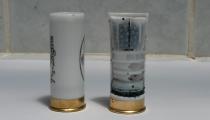Most moderately priced shotguns will last a lifetime if well looked after. The most common shotgun calibre is 12 gauge (and 12 gauge ammunition in less expensive than other gauge ammo).
There is also a wider range of 12 gauge guns available and concerns about recoil can be addressed with careful selection of the type of gun, its weight and the type of ammunition.
There are three aspects to consider when selecting your gun – type, fit and weight.
There are four types of shotgun: double barrel (side-by-side or over-and-under), semi-automatic, pump action and single barrel break action guns.
Double Barrel Guns
Double barrel guns are the traditional type, and available as side-by-side or over-and-under. Their advantages include: two barrels (and two choke options); quick and easy to take apart for cleaning, storage, transport and security; highly reliable (fewer moving parts) and in terms of safety can be carried or held with ‘broken’ with shells in the breech – an excellent comfort for experienced hunters introducing novices to the sport.
Semi-Automatic
Now widely used, semis have the advantages of reduced recoil and a larger magazine capacity enabling multiple shots (note NZ firearms law restricts semi auto shotguns to no more than five shots commensurate to the shotguns chambering).
But note that some Fish & Game regions now further restrict the number of shots before reloading.
Their disadvantages include having one barrel and therefore one choke (although nearly all semis come with a variety of choke tubes, changing choke between shots is both impractical and very dangerous), cleaning a semi is more time consuming and critical, and there is the safety aspect of having a shell in breech under a closed action after the first shot.
Pump Action
Similar to a semi, but the action is cycled by the shooter moving the fore end backwards and forwards. While safer than a semi (as the breech can be held open and empty), the pump action suffers the same disadvantages as the semi in terms of one choke and more complex cleaning. However, for a multi-shot gun, pump actions are inexpensive compared to semis.
Single Barrel
Single barrel guns are work on the same principle as double barrel guns, but (you guessed it) have one barrel. Single barrel break action guns are generally inexpensive, and develop good shooting skills early on, as shooters make sure of their first shot.
Beretta Xtrema2 Max-4 HD - Semi Automatic
 Benelli Nova Pump Synthetic 20 gauge - Pump Action
Benelli Nova Pump Synthetic 20 gauge - Pump Action
 Beretta 687 EELL - Over and Under Double Barrel
Beretta 687 EELL - Over and Under Double Barrel
 Beretta 471 EL Silver Hawk - Side by Side Double Barrel
Beretta 471 EL Silver Hawk - Side by Side Double Barrel

Lefthanders
A quick note for left-handers. Some guns come with ‘cast’, where the stock is ‘cast off’ (aligned to the right) to suit right-hand shooters. Ideally, left-hand shooters require ‘cast on’. Fortunately, many new guns (especially semis and pumps) have a neutral cast and come with spacers to adjust cast and drop. In any event, both cast and drop can be inexpensively adjusted by a gunsmith to suit individuals, and if you plan on doing a lot of shooting, this is strongly recommended.
Getting A Good Fit
Put the butt of the gun in the crook of your elbow (right arm for right-handers) and place your index finger on the trigger. If there is a good flush fit, the stock length is probably okay.
Bring the gun to your shoulder and put your cheek against the stock while looking dead centre down the rib. If there is no strain on your neck muscles, that’s good. Next, lower the gun, close your eyes, and bring the gun up to a shooting position. If everything is lined up when you open your eyes, that’s good.
Stock cast and length can often be adjusted with a selection spacers provided with a new gun, or alternatively, is a straight forward (albeit expensive) operation by a gunsmith.
Weight
Weight is important as this effects how much recoil is absorbed by the gun. Too light a gun may have a heavy recoil, but a heavy gun may tire the upland game hunter who must carry the gun all day. For hunting, a barrel length of 28 inches ( 710 mm) is very satisfactory.
Chokes
A choke is a restriction at the end of the barrel which determines the spread of your shot. Most modern guns have interchangeable screw-in chokes, and selecting the right choke for a particular situation is extremely important. It is also crucial to ensure that both choking and the gun itself are compatible with modern steel shot. For more information on choking, readers are strongly encouraged to talk with experienced hunters, their hunting retailer, or view the chapter on chokes and patterning on our Introduction to Duck Hunting DVD (available online or from your regional Fish & Game office).
 Ammunition
Ammunition
The range of 12 gauge ammunition can be bewildering for a new hunter. We cover the basics on our Ammunition page but suggest you discuss any queries with an experienced hunter, your local hunting retailer, or contact your regional Fish & Game office.